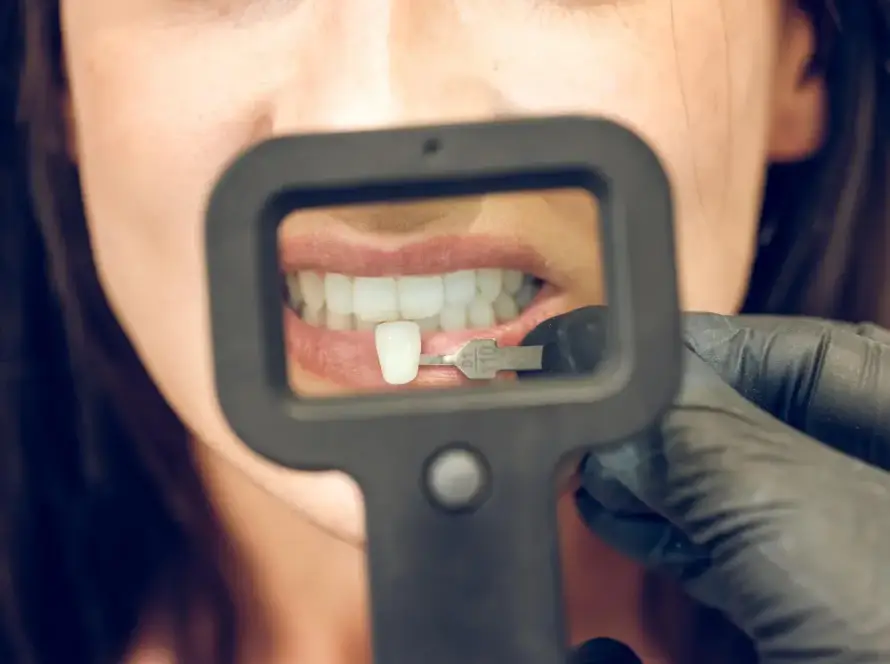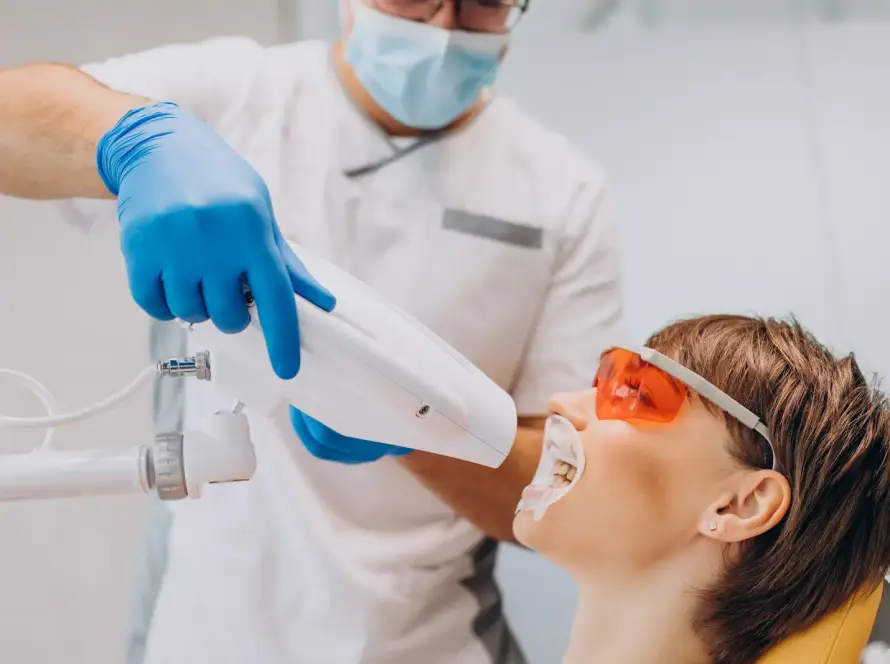Tartar, also known as dental calculus, is a hardened form of plaque that accumulates on the surfaces of teeth and along the gumline. It is a yellowish or brownish substance that cannot be easily removed through regular brushing and flossing.
When plaque is not adequately removed from the teeth, it hardens and forms tartar. The presence of tartar on the teeth can have several negative effects.
- Gum Disease: Tartar is a major contributor to the development of gum disease. The bacteria in tartar release toxins that irritate the gums, leading to inflammation and infection. This can cause gum recession, loose teeth, and even tooth loss if left untreated.
- Bad Breath: Tartar can contribute to persistent bad breath, also known as halitosis. The bacteria in tartar release foul smelling compounds that can leave a lasting odor in the mouth.
- Stains and Discoloration: Tartar can cause teeth to appear yellow or brown due to its accumulation and adherence to the tooth surfaces. This can lead to aesthetic concerns and a dull appearance of the smile.
- Difficulty in Brushing and Flossing: Tartar creates a rough surface on the teeth, making it harder to thoroughly clean the teeth with a toothbrush or floss. This can allow bacteria to thrive and multiply, leading to further plaque buildup and dental problems.
- Increased Risk of Cavities: Tartar provides a conducive environment for bacteria to thrive, which can increase the risk of tooth decay and cavities. The presence of tartar on the teeth can make it more challenging for fluoride in toothpaste or mouthwash to reach the enamel and protect it from acid attacks.
Understanding the effects of tartar underscores the importance of regular dental cleanings and maintaining good oral hygiene practices. Removing tartar on teeth regularly through professional cleanings can help prevent gum disease, maintain fresh breath, and keep teeth looking their best.
What is Tartar?
Tartar, also known as dental calculus, is a hard, yellowish deposit that forms on the surface of teeth. It is a result of the mineralization of plaque, a sticky film of bacteria that forms on teeth. When plaque is not adequately removed through regular brushing and flossing, it hardens and turns into tartar.
Tartar is composed of minerals, such as calcium and phosphate, which are present in saliva. It is notorious for its rough texture, making it easier for plaque to accumulate and adhere to teeth. Once tartar forms, it provides a conducive environment for bacteria to grow, leading to gum inflammation and potential oral health problems.
Unlike plaque, tartar is not easily removed by regular brushing and flossing alone. It requires professional dental intervention to be effectively eliminated. Regular dental cleanings are essential to remove tartar buildup and prevent its adverse effects on oral health.
Without proper removal, tartar can contribute to various oral health issues, including gum disease, tooth decay, and bad breath. It can also cause discoloration of teeth, making them appear yellow or stained.
Understanding what tartar is and its detrimental effects emphasizes the importance of regular dental check ups and cleanings. By keeping tartar at bay, individuals can maintain a healthy smile and reduce the risk of oral health problems.
Professional Tartar Removal Procedures
When it comes to tartar buildup, professional assistance is essential for thorough and effective removal. Dentists and dental hygienists have the expertise and specialized tools required to remove tartar safely and efficiently.
Here are some professional tartar removal procedures commonly used by dental professionals:
- Scaling: This procedure involves using a handheld tool called a scaler to remove tartar from the surface of the teeth. The dentist or dental hygienist carefully scrapes away the hard deposits, focusing on areas where tartar has accumulated, such as along the gumline and between teeth.
- Ultrasonic scaling: This technique utilizes an ultrasonic scaler that vibrates at a high frequency. The vibrations help break down tartar, making it easier to remove. The scaler also produces a water spray that helps flush away debris and keeps the area clean during the procedure.
- Polishing: After tartar removal, the dentist or dental hygienist may polish the teeth using a special paste and a rotating brush. This step helps remove any residual stains and gives the teeth a smooth and shiny finish.
- Dental laser treatment: In some cases, dentists may use laser technology to remove tartar. The laser emits a concentrated beam of light that targets and breaks down the tartar buildup. This method is less invasive and may cause less discomfort compared to traditional scaling techniques.
- Root planing: If tartar has extended below the gumline, a procedure called root planing may be necessary. This involves smoothing the root surfaces of the teeth to remove tartar and bacteria. Root planing helps prevent further progression of gum disease and promotes healing of the gums.
It is important to note that professional tartar removal procedures should only be performed by trained dental professionals. Regular visits to the dentist for professional cleanings are crucial to maintain optimal oral health and prevent tartar buildup. Contact us to ask professional dentists.
At Home Tartar Removal Techniques
While professional dental cleanings are the most effective way to remove tartar, there are also some at home techniques that can help to minimize tartar buildup between dental visits. These techniques, when used in conjunction with regular brushing and flossing, can contribute to better oral health. Here are a few at home tartar removal techniques:
- Brushing with baking soda: Baking soda is a natural cleanser that can help to remove plaque and tartar buildup. Mix a small amount of baking soda with water to create a paste, then apply it to your toothbrush. Gently brush your teeth for two minutes, focusing on areas where tartar tends to accumulate.
- Using an electric toothbrush: Electric toothbrushes are often more effective at removing tartar compared to manual toothbrushes. The rotating bristles can reach those hard to reach areas and break up tartar deposits. Ensure you use the toothbrush correctly and follow the manufacturer’s instructions.
- Oil pulling: This ancient technique involves swishing oil (such as coconut oil or sesame oil) around in your mouth for 10-15 minutes. The oil helps to pull out bacteria and plaque from the teeth and gums, reducing tartar buildup. Spit out the oil and rinse your mouth thoroughly after oil pulling.
- Saltwater rinse: A saltwater rinse can help to reduce bacteria in the mouth, preventing tartar formation. Mix half a teaspoon of salt with warm water and use it as a mouthwash. Swish the solution around in your mouth for about 30 seconds before spitting it out.
- Chewing sugarless gum: Chewing sugarless gum after meals can stimulate saliva production, which can help to wash away food particles and reduce tartar formation. Look for gum with the American Dental Association (ADA) seal to ensure it is tooth friendly.
Remember, while these at home techniques can be beneficial, they should not replace professional dental cleanings. Regular visits to the dentist are essential for thorough tartar removal and maintaining optimal oral health.
What Are The Symptoms of Tartar On Teeth?
Tartar, also known as dental calculus, is a hardened plaque that forms on the teeth and gum line. It is important to recognize the symptoms of tartar build up to prevent oral health problems. Here are some common symptoms of tartar on teeth:
- Yellow or brownish discoloration: One of the first signs of tartar is the noticeable change in tooth color. Tartar can cause the teeth to appear yellow or brownish, making them look stained and unattractive.
- Bad breath: Tartar buildup provides a perfect environment for bacteria to thrive. As the bacteria multiply, they release foul smelling gases that result in persistent bad breath, regardless of oral hygiene practices.
- Gum inflammation and bleeding: Tartar irritates the gums, causing them to become red, swollen, and tender. When brushing or flossing, you may notice bleeding gums, which is a common indicator of gum disease.
- Gum recession: As tartar continues to accumulate, it can gradually cause the gums to recede, exposing the tooth roots. Gum recession can lead to tooth sensitivity and make the teeth appear longer than usual.
- Formation of pockets: Tartar buildup can cause the gums to pull away from the teeth, creating pockets or gaps. These pockets provide a space for more bacteria to accumulate, leading to further plaque and tartar formation.
- Tooth mobility: In advanced cases, tartar buildup can weaken the structures supporting the teeth, including the gums and bone. This can lead to tooth mobility or even tooth loss if left untreated.
It is essential to consult a dentist if you experience any of these symptoms. Regular dental cleanings and proper oral hygiene practices can help remove tartar and prevent its recurrence, ensuring a healthier and more confident smile.
The Impact of Tartar On Overall Oral Health
Tartar, also known as dental calculus, can have a significant impact on overall oral health if left unaddressed. Here are some key repercussions of tartar buildup:
- Gum Disease: Tartar acts as a breeding ground for harmful bacteria, leading to gum disease. As tartar accumulates, it irritates the gum line, causing inflammation and gingivitis. If not treated, this can progress to periodontitis, where the gums start to pull away from the teeth, leading to bone loss and tooth loss.
- Bad Breath: Tartar harbors bacteria that release foul smelling sulfur compounds. This can contribute to persistent bad breath, affecting a person’s self confidence and social interactions.
- Tooth Decay: Tartar deposits provide a rough surface where plaque can easily build up. Plaque, a sticky film composed of bacteria and food particles, produces acids that attack tooth enamel, leading to cavities and tooth decay.
- Staining and Discoloration: Tartar is often yellow or brown in color, making teeth appear stained and discolored. This can affect a person’s smile and confidence in their appearance.
- Difficulty in Oral Hygiene: Once tartar forms, it becomes extremely difficult to remove with regular brushing and flossing. The hard, calcified deposits require professional intervention, such as scaling and root planing, to effectively eliminate the buildup.
Regular dental check ups and professional cleanings are crucial to remove tartar and prevent its negative impact on oral health. By maintaining proper oral hygiene practices and seeking professional care, individuals can prevent tartar buildup and maintain a healthy smile.
The Connection Between Tartar and Gum Disease
Tartar buildup on teeth can lead to the development of gum disease. When plaque, a sticky film of bacteria, is not removed effectively, it hardens and turns into tartar. Tartar acts as a breeding ground for harmful bacteria and toxins, which can irritate and inflame the gums.
As tartar accumulates along the gumline, it creates a rough surface that allows bacteria to adhere more easily. This can lead to gum inflammation, known as gingivitis, which is the early stage of gum disease. Symptoms of gingivitis include swollen, tender, and bleeding gums.
If left untreated, gingivitis can progress to periodontitis, a more severe form of gum disease. Periodontitis damages the soft tissues and bones that support the teeth, leading to tooth loss. It can also cause bad breath, receding gums, and the formation of deep pockets around the teeth.
Regular removal of tartar through professional dental cleaning is essential in preventing gum disease. It helps to eliminate the source of bacteria and reduces the risk of inflammation and infection. Maintaining good oral hygiene practices, such as brushing twice a day and flossing daily, also contributes to tartar prevention and overall gum health.
It is important to note that individuals with certain risk factors, such as smoking, diabetes, and a weakened immune system, may be more prone to tartar buildup and gum disease. Regular dental check ups and cleanings, along with proper oral hygiene, can help mitigate these risks and maintain optimal oral health.
Maintaining Tartar Free Teeth for The Long Term
To ensure long term oral health, it is crucial to maintain tartar free teeth. Tartar, a hardened form of plaque, can lead to various dental issues such as cavities, gum disease, and bad breath. Here are some key practices to keep your teeth tartar free:
- Brush regularly: Brushing your teeth at least twice a day with a fluoride toothpaste helps remove plaque buildup, preventing it from turning into tartar. Use a soft bristled toothbrush and clean all surfaces of your teeth using gentle, circular motions.
- Floss daily: Regular flossing removes plaque and food particles from the areas between your teeth and along the gumline where a toothbrush cannot reach. Be sure to use proper flossing technique and gently glide the floss into the spaces between your teeth.
- Consider mouthwash: Adding an antimicrobial mouthwash to your oral hygiene routine can help kill bacteria that contribute to plaque formation. Look for a mouthwash that is specifically formulated to reduce tartar buildup.
- Eat a balanced diet: A nutritious diet plays a significant role in maintaining healthy teeth and gums. Limit consumption of sugary and acidic foods as they promote plaque formation. Instead, include foods rich in calcium and vitamin C in your diet to strengthen teeth and gums.
- Visit your dentist regularly: Professional dental cleanings are essential for the removal of tartar that cannot be eliminated through regular oral hygiene practices. Schedule regular dental check ups, usually every six months, to prevent tartar buildup and address any potential dental issues promptly.
By incorporating these practices into your daily routine and seeking professional dental care, you can maintain tartar free teeth for the long term, promoting excellent oral health and a radiant smile. Remember, prevention is always better than cure when it comes to dental problems.
Does Tartar Smell Bad?
Tartar, also known as dental calculus, is a hard, yellowish deposit that forms on the teeth due to the accumulation of plaque over time. One common concern people have about tartar is whether it causes bad breath or a foul smell.
Unfortunately, the answer is yes. Tartar can contribute to bad breath or halitosis. This is because tartar acts as a magnet for bacteria, food particles, and other debris in the mouth. As these substances accumulate on the surface of tartar, they can release unpleasant odors.
Furthermore, the bacteria that thrive in the tartar can produce volatile sulfur compounds (VSCs), which are responsible for the foul smell. These VSCs have a distinct rotten egg odor that can be quite noticeable, especially when talking or exhaling.
It is essential to note that even with good oral hygiene practices, it is challenging to eliminate tartar completely at home. Regular dental cleanings by a professional are necessary to remove tartar and prevent its buildup. Dentists can remove tartar using special tools and techniques, ensuring a thorough cleaning that is difficult to achieve with regular brushing and flossing alone.
In summary, tartar can indeed produce a bad smell due to the accumulation of bacteria and the release of volatile sulfur compounds. Regular dental cleanings are crucial to keep tartar at bay and maintain fresh breath.















